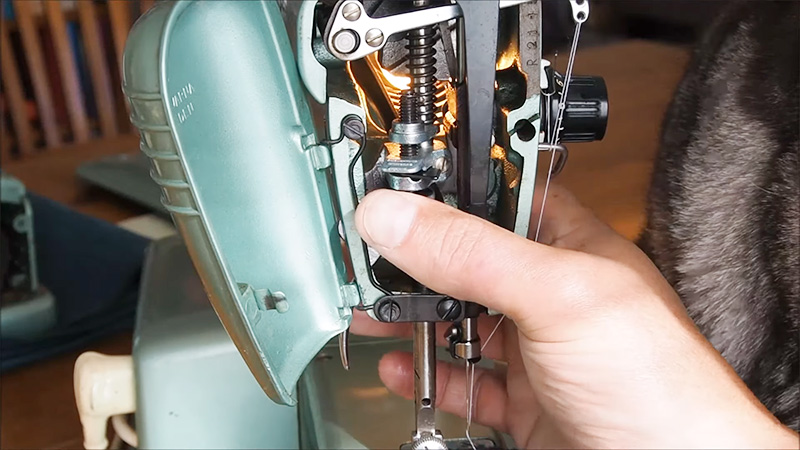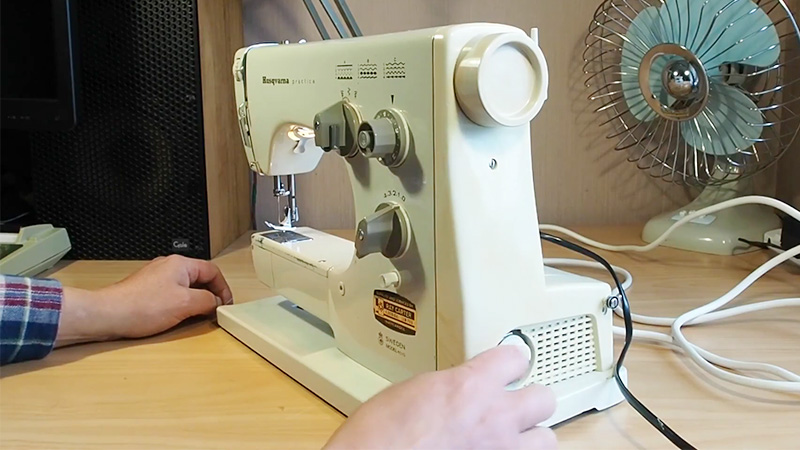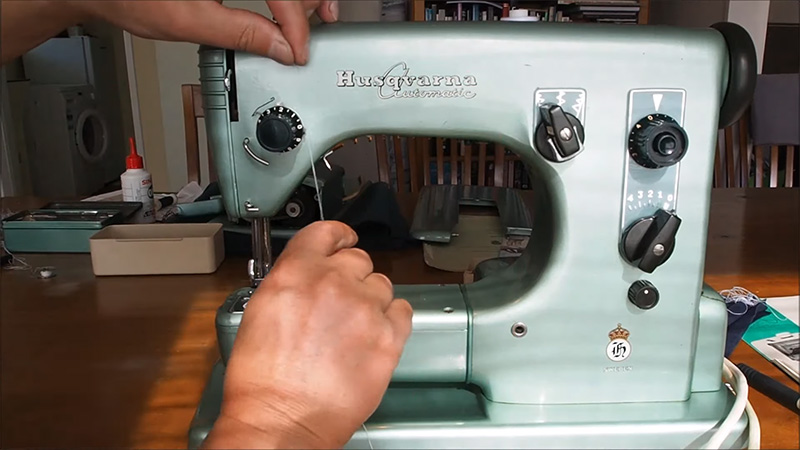When you own a Husqvarna sewing machine, you know how reliable and versatile it is. But even the best machines can have some problems from time to time.
That’s why we’ve prepared this guide to help you troubleshoot and fix some of the most common issues with your Husqvarna sewing machine.
Whether it’s a jammed bobbin, a broken needle, or a loose tension, we’ll show you how to identify and solve the problem in a few simple steps.
You don’t need to be an expert or have any special tools to do it. Just follow our instructions, and you’ll be back to sewing quickly.

Common Husqvarna Sewing Machine Issues
Husqvarna sewing machines are generally known for their quality and reliability. However, like any mechanical or electronic device, they can experience issues from time to time.
Here are some common problems that users may encounter with Husqvarna sewing machines, along with possible solutions:
Thread Breaking or Snapping
Cause: Thread breakage can occur due to a variety of reasons. Ensure you’ve correctly threaded the machine following the threading path in the user manual.
Using old or low-quality thread can also lead to breakage. Additionally, a rough spot or burr on the needle can cause the thread to snap.
Solution: Rethread the machine carefully, following the threading path. Use high-quality thread that’s compatible with your machine. Inspect the needle for any damage or rough spots and replace it if necessary.
Skipped Stitches
Cause: Skipped stitches can result from an improperly inserted or dull needle, incorrect tension settings, or issues with the fabric.
Solution: Ensure that the needle is correctly inserted and securely tightened. Adjust the tension settings according to the fabric you’re sewing; consult your user manual for guidance.
Sometimes, using a different needle type or size may improve stitch quality, especially when working with specialty fabrics.
Machine is Noisy
Cause: Unusual noises or excessive vibrations can be unsettling. Start by checking if the needle is correctly inserted and tightened. If the problem persists, it could indicate a mechanical issue.
Solution: Confirm the needle is inserted correctly and tightened in the clamp. If the noise or vibrations continue, it’s advisable to consult your user manual for troubleshooting steps or contact a professional technician for a thorough inspection.
Uneven Stitches
Cause: Uneven stitches may occur due to issues like incorrect thread tension, the wrong needle for the fabric, or a dirty feed dog.
Solution: Adjust the thread tension based on your fabric and thread. Gradual adjustments and testing on scrap fabric can help achieve even stitches.
Use the correct type and size of needle for your project; refer to your user manual for guidance. Regularly clean the feed dog area to prevent lint buildup, which can affect stitch quality.
Bobbin Thread Tangles or Loops
Cause: Tangled or looped bobbin thread can result from incorrectly wound bobbins, improper threading, or bobbin tension issues.
Solution: Wind bobbins smoothly and evenly, following the user manual’s guidelines. Ensure that the bobbin is inserted into the bobbin case and threaded correctly.
Adjust the bobbin tension as needed; your user manual may provide instructions.
Needle Breakage
Cause: Needle breakage is often caused by using the wrong type or size of needle for your project or accidentally sewing over pins.
Solution: Always choose the appropriate needle for your fabric, considering factors like weight and type. Remove pins before the needle reaches them to prevent breakage and potential damage to the machine.
Feed Dog Issues
Cause: Feed dogs may become clogged with lint or damaged over time.
Solution: Regularly clean the feed dogs and the surrounding area using a brush or lint roller to prevent lint buildup, which can affect fabric feeding. If the feed dogs are damaged, consult a technician for repair or replacement.
Machine not Powering On
Cause: Power-related issues can be caused by problems with the power supply, loose cables, or a blown fuse.
Solution: Check the power cord for any damage or loose connections, ensuring it’s securely plugged into a functional outlet. Inspect the fuse in the machine’s power plug and replace it if necessary. Refer to your user manual for the correct fuse specification.
Maintenance Tips for Your Husqvarna Sewing Machine

Regular maintenance is essential to keep your Husqvarna sewing machine running smoothly and producing high-quality stitches.
Here are some essential maintenance tips:
Cleaning
Turn off and unplug your machine before cleaning. Use a soft brush or lint roller to remove dust, lint, and debris from the bobbin area, feed dogs, and other accessible parts. Periodically remove the throat plate for a more thorough cleaning.
Needle Replacement
Replace the sewing machine needle after every 8-10 hours of sewing or when you notice any signs of damage, such as bends or burrs. Use the appropriate needle type and size for your fabric.
Oiling
Refer to your sewing machine’s user manual for specific instructions on oiling your model. Not all sewing machines require oiling. If your machine does, use high-quality sewing machine oil and follow the recommended schedule.
Thread Tension
Regularly inspect and adjust the upper and lower thread tensions to ensure they are correctly set for your sewing project. Consult your user manual for guidance on adjusting tension.
Bobbin Maintenance
Remove the bobbin and bobbin case regularly to clean out any lint or debris. Wind bobbins smoothly and evenly to prevent bobbin-related issues.
Thread and Bobbins
Use good-quality thread that is suitable for your sewing machine and fabric. Replace bobbins when they become worn or damaged.
Storage
Protect your machine when not in use by covering it with a dust cover or placing it in a sewing machine case. This prevents dust and debris from accumulating.
Proper Storage
Store your sewing machine in a cool, dry place away from direct sunlight and extreme temperatures. If you need to transport your machine, use a sturdy carrying case designed for sewing machines.
Annual Servicing
Consider having your sewing machine professionally serviced by a qualified technician at least once a year, mainly if you use it frequently.
User Manual
Always consult your sewing machine’s user manual for maintenance instructions, including cleaning and lubrication schedules.
When to Take Your Husqvarna Sewing Machine to a Professional?

Knowing when to seek professional help with your Husqvarna sewing machine is crucial to prevent further damage and ensure safe operation.
Here are some situations in which it’s advisable to consult a qualified technician:
Persistent Mechanical Issues
When your sewing machine continues to experience mechanical problems despite your attempts at troubleshooting, it’s advisable to consult a qualified technician. This includes issues like unusual noises, excessive vibrations, or parts that are not moving correctly.
Electrical Problems
Suspecting an electrical issue, such as a faulty power cord or plug, warrants seeking professional assistance. Attempting to fix electrical problems without proper expertise can be dangerous.
Bobbin Case Damage
Noticing significant damage to the bobbin case or feed dogs necessitates having them inspected and repaired by a qualified technician. Attempting to fix these components without proper expertise can lead to further damage.
Timing and Synchronization Issues
When your sewing machine’s timing or synchronization is off, it requires precise adjustments that a professional best handles. Improperly adjusted timing can cause stitching problems and potentially damage the machine.
Computerized Malfunctioning
For computerized or electronic sewing machines, professional help for malfunctions is essential. These components require specialized knowledge to diagnose and repair.
Serious Thread
Experiencing severe and consistent thread or tension issues that are not resolved with basic adjustments warrants consulting a professional. They can diagnose the underlying cause and make necessary adjustments or repairs.
Motor or Drive Belt Issues
Suspecting a problem with the sewing machine’s motor or drive belt is a sign to have a technician inspect and repair these components. These are critical parts for the machine’s operation.
Safety Concern
Identifying a safety hazard with your sewing machine, such as exposed wiring or a malfunctioning foot pedal, should prompt you to avoid using the machine and seek professional help immediately.
Service Agreement Coverage
If your sewing machine is still under warranty or covered by a service agreement, it’s advisable to consult the manufacturer or authorized service provider for repairs. Attempting self-repairs may void the warranty.
Lack of Expertise
If you’re unsure about addressing a specific issue or lack the necessary expertise, it’s best to err on the side of caution and consult a professional. Attempting complex repairs without the proper knowledge can lead to further damage.
FAQs
What should I do if my sewing machine jams?
Turn off and unplug the machine. Remove fabric and tangled threads. Clean the bobbin area, rethread, and resume.
Why is my machine making a loud noise?
Unusual noises may indicate a mechanical issue. Stop, inspect, and consult a technician if needed.
How can I fix uneven stitches?
Adjust thread tension, use the right needle, and ensure correct threading.
How do I stop bobbin thread tangling?
Rewind the bobbin evenly, rethread the case, and adjust the tension if needed.
What if the foot pedal isn’t working?
Check the power supply, cords, and connections. Consult a technician for electrical issues.
Wrap Up
Mastering troubleshooting for your Husqvarna sewing machine is a valuable skill for any enthusiast or professional. With this guide, you can address common issues, ensuring your machine operates smoothly.
You can diagnose and resolve problems efficiently, from thread tensions to mechanical adjustments. Consider your user manual for model-specific instructions and exercise caution when dealing with electrical components.
When faced with complex or persistent issues, seeking professional help ensures your cherished sewing companion’s longevity and optimal performance. With these skills, you’re poised to embark on creative sewing projects confidently and precisely.
Leave a Reply